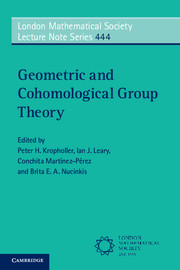Book contents
- Frontmatter
- Contents
- List of Participants
- Preface
- Obstructions for subgroups of Thompson's group V
- Groups of homological dimension one
- Braided diagram groups and local similarity groups
- On Thompson's group T and algebraic K-theory
- Special cube complexes (based on lectures of Piotr Przytycki)
- A hyperbolic group with a finitely presented subgroup that is not of type FP3
- The structure of Euclidean Artin groups
- Finitely presented groups associated with expanding maps
- On characteristic modules of groups
- Controlled algebra for simplicial rings and algebraic K-theory
- References
Obstructions for subgroups of Thompson's group V
Published online by Cambridge University Press: 11 October 2017
- Frontmatter
- Contents
- List of Participants
- Preface
- Obstructions for subgroups of Thompson's group V
- Groups of homological dimension one
- Braided diagram groups and local similarity groups
- On Thompson's group T and algebraic K-theory
- Special cube complexes (based on lectures of Piotr Przytycki)
- A hyperbolic group with a finitely presented subgroup that is not of type FP3
- The structure of Euclidean Artin groups
- Finitely presented groups associated with expanding maps
- On characteristic modules of groups
- Controlled algebra for simplicial rings and algebraic K-theory
- References
Summary
Abstract
Thompson's group V has a rich variety of subgroups, containing all finite groups, all finitely generated free groups and all finitely generated abelian groups, the finitary permutation group of a countable set, as well as many wreath products and other families of groups. Here, we describe some obstructions for a given group to be a subgroup of V.
Introduction
Thompson constructed a finitely presented group now known as V as an early example of a finitely presented infinite simple group. The group V contains a remarkable variety of subgroups, such as the finitary infinite permutation group S∞, and hence all (countable locally) finite groups, finitely generated free groups, finitely generated abelian groups, Houghton's groups, copies of Thompson's groups F, T and V, and many of their generalizations, such as the groups G n,r constructed by Higman [9]. Moreover, the class of subgroups of V is closed under direct products and restricted wreath products with finite or infinite cyclic top group.
In this short survey, we summarize the development of properties of V focusing on those which prohibit various groups from occurring as subgroups of V.
Thompson's group V has many descriptions. Here, we simply recall that V is the group of right-continuous bijections from the unit interval [0, 1] to itself, which map dyadic rational numbers to dyadic rational numbers, which are differentiable except at finitely many dyadic rational numbers, and with slopes, when defined, integer powers of 2. The elements of this group can be described by reduced tree pair diagrams of the type (S, T, π) where π is a bijection between the leaves of the two finite rooted binary trees S and T.
Higman [9] gave a different description of V, which he denoted as G2,1 in a family of groups generalizing V.
Obstructions
Higman [9] described several important properties of V which can serve as obstructions to subgroups occurring in V.
Theorem 2.1 ([9])An element of infinite order in V has only finitely many roots.
This prevents all Baumslag-Solitar groups Bm,n = <a, b | anb = bam> from occurring as subgroups of V, if m properly divides n; see [13].
- Type
- Chapter
- Information
- Geometric and Cohomological Group Theory , pp. 1 - 4Publisher: Cambridge University PressPrint publication year: 2017
References
- 2
- Cited by



